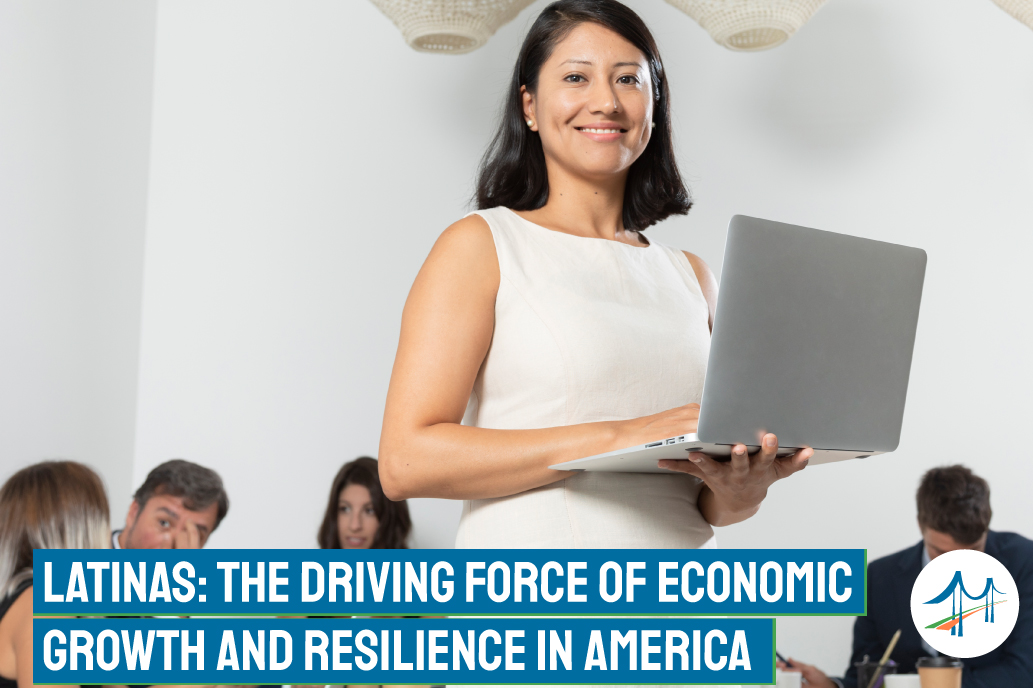Hispanic women have represented a critical and growing segment of the U.S. labor market and economy for many years. Post-pandemic, this has translated to increased resilience of the American workforce, supporting the country’s economic recovery.
While Latinas’ participation in the labor market has historically been lower than non-Hispanic white women, this gap has narrowed over the years and as of 2022 Hispanic women actually surpassed their white counterparts in labor force participation. With 12.8 million Hispanic women in the American labor force today, they represent more than 17% of all women workers, according to the U.S. Bureau of Labor Statistics. This trend is expected to continue, as Hispanic Americans are projected to account for 78% of new workers between 2020 and 2030.
Latinas’ Comeback Leading Post-Pandemic Recovery
Despite being disproportionately impacted by pandemic-induced job loss, Latina workers are making a strong comeback.
As the economic blow of the pandemic became apparent in April of 2020, the unemployment rate for Hispanic women hit 20.1%, higher than that of men or women of any other racial or ethnic group. This was in part due to Latina workers’ concentration in industries such as leisure and hospitality, which were incompatible with the abrupt shift to remote work.
However, Latinas bounced back boldly and by September 2022 the unemployment rate among Hispanic women was down to 3.6%, below even the pre-pandemic rate of 4.4% in January 2020. This resiliency has had a profound impact on the country’s recovery from the pandemic’s economic damage.
Entreprenuers Fueling the Nation’s Economy
Latinas are not only the most active workforce in the United States, they are also the fastest-growing segment of the nation’s business sector. The Aspen Institute asserts that the Latino community has become the nation’s economic powerhouse, and Latinas are its engine. The American Express State of Women-Owned Businesses Report reports that there are over two million Latina-owned business in the country, representing 17% of all women-owned businesses. The number of Hispanic women small business owners is growing at a faster rate than any other segment: the number of firms owned by Latinas grew 164% from 2007 to 2018, nearly three times the growth rate of WOBs as a whole.
It is important to note that the Hispanic community is the most diverse major ethnic group in the U.S., with great variation in regard to race, country of origin, educational attainment, and financial resources. While this diversity results in both challenges and opportunities for Hispanic businesswomen, many turn their challenges into opportunity. According to the U.S. Census Bureau’s Survey of Business Owners, foreign-born Hispanic women in the U.S. pursue entrepreneurship approximately twice as frequently as native-born Hispanic women.
Angélica Fuentes, a Latin American businesswoman and impact investor recognized by Forbes as one of Mexico’s most influential women, says that Latinas are a crucial part of the U.S. political, social, and economic life, and the newest wave of the feminist movement has pushed Latinas to occupy leadership positions. “Today, it is possible to see [Latina] women leading ventures, directing companies, and holding public office positions in the United States, which sets a different course in history,” states Angélica.
The contribution of Hispanic women entrepreneurs to the country’s greater economy should not be overlooked. Latina-owned businesses employ over 600,000 workers, representing a 74.5% increase from 2007-2018. In the words of the Aspen Institute Latinos and Society Program’s Executive Director Abigail Golden-Vazquez, “Latinas are a powerful secret ingredient to the nation’s success.”
Unrealized Potential
Latinas’ contributions to the American economy are impressive, yet their full potential has yet to be unlocked.
Unfortunately, Hispanic women in the U.S. workforce still experience significant disparities, driven in large part by occupational segregation. Latinas continue to be overrepresented in low-wage occupations and face barriers to economic opportunity, often suffering economic insecurity and poor working conditions. What’s more, Latinas are more affected by the gender wage gap than any other major racial or ethnic group in the U.S. labor market: Hispanic women earn just 54 cents for every dollar earned by a non-Hispanic white man.
What about the link to education? The proportion of Hispanic women aged 25 and older who earned at least a bachelor’s degree nearly doubled between 2000 and 2020, according to the American Association of University Women. And yet, even with this significant growth in educational attainment, the wage gap between Hispanic women and non-Hispanic white men fell by just 7% during the same period, as reported by the U.S. Department of Labor. In fact, even Latinas with a bachelor’s degree have median weekly earnings below those of white men with an associate degree or some college.
Hispanic businesswomen are often confronted with a double bias against both their race and gender, which means they face more barriers to starting and growing their businesses than other groups, such as a lack of networking and mentorship opportunities, and reduced access to loans, investment dollars, and other much-needed forms of funding and resources.
These disparities are often exacerbated for foreign-born Hispanic women, who are more likely to lack the advanced education, financial literacy, language skills, and access to information necessary to fully navigate the entrepreneurial system, according to the National Women’s Business Council’s Report on Hispanic Women Entrepreneurship. Golden-Vazquez of the Aspen Institute explains that if investment in Latina-owned businesses matched other women-owned businesses, they could add 80,000 new jobs and $155 billion to the economy.
While an increasing number of organizations are finally beginning to address these disparities by providing tools, educational opportunities, and business training, there is still a lot of ground to cover in order to achieve parity and enable Latinas to reach their full potential and thus accelerate U.S. economic growth.
To enact lasting change, businesses, organizations, investors, and other stakeholders must put forth a concerted effort to continue empowering Latina workers and entrepreneurs by expanding training and mentorship programs, providing resources to improve Latinas’ financial literacy, financial inclusion and access to capital, and through other initiatives and policies that strive to improve Latinas’ working conditions and economic opportunities. Doing so will make the American economy as a whole more resilient and increase shared prosperity and economic security for the entire nation.
©Image by Freepik


